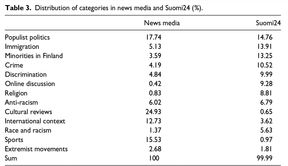Discussions about racism strongly differ in the Finnish news media and discussion forums

The Finnish public discourse about racism varies considerably across newspapers and discussion forums. This is shown in the results of a study conducted at Aalto University, the University of Helsinki and Tampere University. Researchers investigated how the concept of racism is used in the Finnish public discourse. They collected data from several traditional news media, such as Helsingin Sanomat, Yleisradio and Aamulehti, as well as from Suomi24 discussion forum during the years 2011–2015.
In the social media participants often use “reverse racism” arguments, seeing minorities, immigration and their defenders as a threat to “the ordinary Finnish people.” On Suomi24, for example, the Swedish-speaking minority was typically referred to as a “racist” power that oppresses Finnish-speaking Finns. The people discussing on discussion forums tended to de-historicize racism or downplay the concept by speaking about terms, such as age racism, and producing neologisms.
“By using words such as ‘language racism’ – which refers to the status of Swedish as a second official language in Finland – detaches racism from its historical power and subordination relations and minimizes experiences of victims of racism. By playing with words in this way, the concept of racism loses its power,” says Associate Professor Mervi Pantti from the University of Helsinki.
In news media, on the other hand, racism is typically linked to either a historical or an international context. Journalists write about it as a serious societal problem – but from an international perspective. Explicit discussions of racism as a system of structural inequality in Finland were not present in this data, and local expressions of racism were addressed mainly in the context of anti-racist campaigns.
According to Professor Kaarina Nikunen from Tampere University, this study shows how the discussions about racism have been “hijacked” on Suomi24 forum. “The voice of racialized individuals remains in the background, which in this case is also influenced by the special characteristics of the selected platform. But I would also like to note that that voice isn’t heard too often in the mainstream media either,” says Nikunen.
Researchers want to remind that Suomi24 does not present all Finnish social media discussions. It was selected in the study, as it is one of the largest non-English discussion forums in Europe.
Researchers conclude that how people understand racism and to what ideological and political ends the notion of racism is used are strongly shaped by media platforms. Matti Nelimarkka, visiting researcher at Aalto University and university lecturer at the University of Helsinki, points out that, when it comes to racism, social media does not discuss about things presented in the news media, or vice versa. “The belief according to which these media platforms are somehow connected isn’t true.”
When social media and news media speak about the same topics, they look at them from different angles
The data gathered from the news media included 5,262 posts, which accounted for about 0.25% of all posts written during the research period, and the data gathered from Suomi24 included 113,410 posts, accounting for about 0.5% of all posts.
The researchers recognized 13 different themes under which people discussed about racism. Some themes, such as cultural reviews, sports and international context, were common also in the news media. Similarly, categories almost exclusively featured on Suomi24 either related to online-specific issues, such as the rules and moderation of online discussion, or were concerned with more controversial issues, such Swedish language when discussed about minorities.
Researchers used data science approaches to recognize which words were commonly together in the textual data and thus created themes. They noticed that even when the traditional media and discussion forums focused on the same topics, they were discussing about them in completely different ways. “Immigration, for example, was often an affectional issue on Suomi24, whereas the news media spoke about it as more of a fact,” Matti Nelimarkka says.
The study was funded by the Academy of Finland and it was done as a collaboration of the University of Helsinki, Aalto University and Tampere University as part of the Racisms and public communications in the hybrid media environment (HYBRA) project.
Further information
Mervi Pantti
Associate Professor, University of Helsinki
Phone +358 40 7014 010
[email protected]
Matti Nelimarkka
Visiting researcher, Aalto University
University Lecturer, University of Helsinki
Phone +358 50 5275 920
[email protected]
Kaarina Nikunen
Professor, Tampere University
Phone +358 40 1904 094
[email protected]
- Published:
- Updated:
Read more news

Join us for the first Aalto Open Science Award Ceremony
All Aaltonians are welcome – no registration required!
Doctoral education pilot arouses wide interest among applicants and corporate partners
The doctoral education pilot has got off to a fast start.
Broadband miniaturized spectrometer research receives QTF annual discovery award 2024
The clarity and compelling presentation of the research were one of the reasons why Doctoral Researcher Md Uddin earned the prize for the research paper, which was published in Nature Communications.